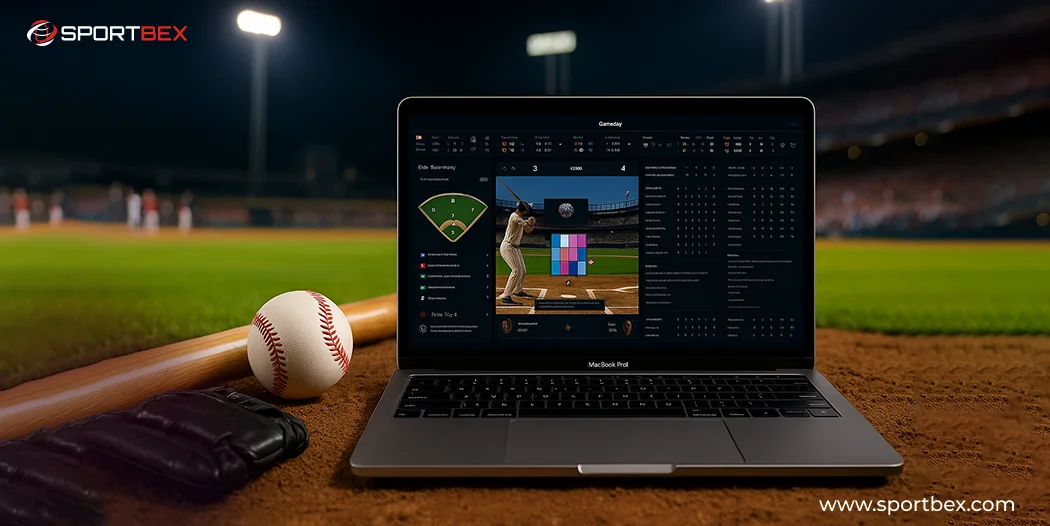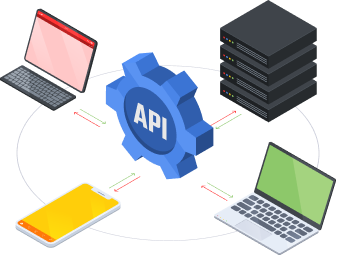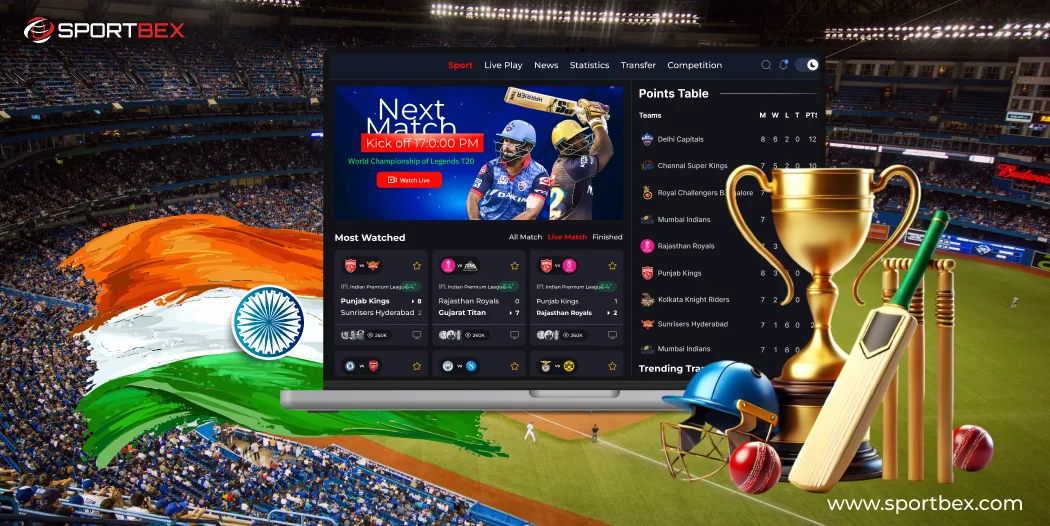Baseball fans don’t want to wait for score updates anymore. They want to see MLB live scores, player stats, and game information instantly. If you’re creating a sports app, website, or dashboard, using Real-time baseball scores is key to making it exciting for users.
This is where Baseball APIs come in. Using API baseball data, developers can get live baseball match scoreboard updates, detailed player stats, and inning-by-inning updates. This information can then be used to create a professional-looking scoreboard. What used to be complicated is now much easier with the right tools.
This guide will show you everything you need to know about making a baseball scoreboard using data from APIs. We’ll cover how to pick the right API and how to set up live updates so fans don’t miss a single pitch.
What is a Baseball Scoreboard?
A baseball scoreboard shows all the important information about a game in a way that’s easy to read. The scoreboards you see at a stadium usually show the basics, like runs, hits, and which inning it is. Digital scoreboards, however, can show a lot more.
Modern digital scoreboards can display detailed player stats, pitch counts, and even weather updates. They can also show multiple games at once, league standings, and Baseball Leagues information to keep fans engaged.
The best scoreboards show a lot of information without being confusing. They use a clean design, clear text, and layouts that work well on both computers and phones.
Digital scoreboards can be interactive. Users can click for player stats, past game data, or set alerts for key plays. This allows personalized viewing, focusing on specific teams or stats.
Benefits of Using a Baseball API for Scoreboards
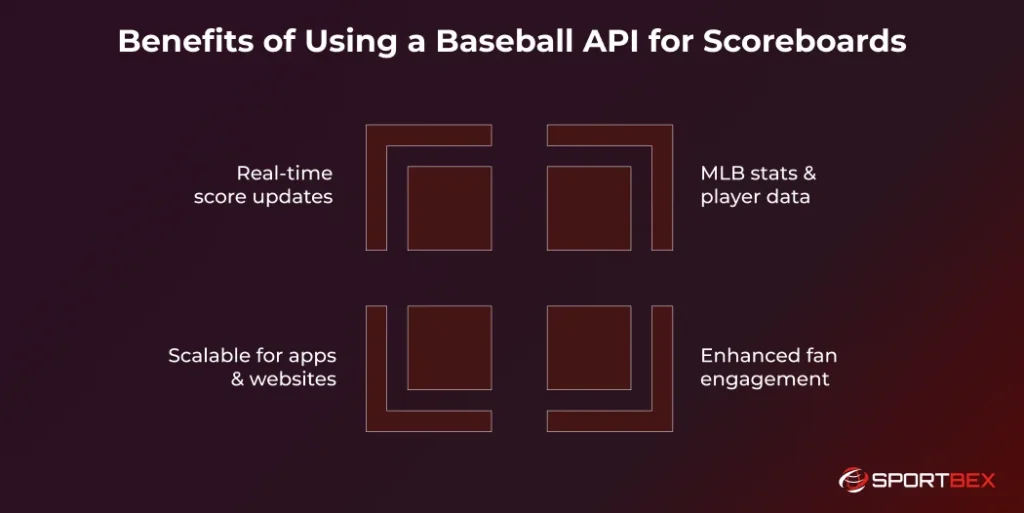
Real-time Score Updates
A Baseball API gives you real-time baseball scores that update on their own, so you don’t have to do it by hand. Good APIs get their information straight from official sources. Scores are accurate and updated instantly during the game.
With real-time updates, users stay engaged with the latest game action. A home run or big play appears on your live baseball match scoreboard within seconds, delivering the instant updates modern sports fans expect.
MLB Stats & Player Data
Baseball APIs provide full access to MLB live scores and detailed player stats. Beyond basic scores, users can view batting averages, ERAs, recent performance, career stats, and even player matchups. This depth of information makes watching games more engaging.
With all this data, you can create baseball scoreboard systems that everyone loves. Casual fans can easily follow the game, while serious fans can dig into advanced numbers and player performance details.
Scalable for Apps & Websites
Our Professional Baseball API can handle a lot of visitors at once. Even when many people are checking scores during big games or playoff series, your scoreboard will stay fast and reliable.
Because our APIs are cloud-based, they automatically adjust to handle more traffic when needed. You won’t have to worry about managing servers or making sure everything runs smoothly. This lets you focus on making awesome scoreboards for your users.
Enhanced Fan Engagement
Our detailed API data lets you build scoreboards where fans can compare players, view historical stats, predict outcomes, and share updates on social media. This transforms score-checking into a fun, interactive activity.
When fans are more involved, they’ll stick around longer, visit more pages, and you’ll have more chances to make money through ads or special features. The API gives you the data you need to create these exciting experiences.
Step-by-Step Guide: Building a Baseball Scoreboard with API Data
Step 1: Get API Access
First, pick a good Baseball API provider and get your access keys. Many providers have different plans, from free ones with basic info to paid ones with lots of data and more requests.
Look into different providers to find one that fits what you need for data, how often it updates, price, and help. There are many Baseball API providers that focus on different types of baseball data.
Want to integrate Real-time baseball scores into your project? Get in touch with us today. We guide you through account setup, data formats, request limits, and available data points. We also provide detailed documentation, code examples, and tools for quick and easy scoreboard development.
Step 2: Fetch Live Scores
Next, you’ll need to get the live baseball match scoreboard data from the API you chose. This involves making requests to the API’s specific URLs. In return, the API will send you structured data, usually in JSON or XML format, which your application can easily process.
Once your connection is set up, you need to test it well. See how it works during live games, after games are over, and even if there are problems with the API. Make sure your app can handle these situations smoothly. This way, your app won’t break if something unexpected happens with the data.
Step 3: Parse the Data
After you get the data from the API, you need to “parse” it. This means identifying key information and converting it into a format your scoreboard can display, turning raw data into organized, readable information.
Most Baseball APIs provide more data than you need for a simple scoreboard. Focus on the key details you want to show now and save extra data for future features.
Always check the data you receive to ensure it’s in the right format and includes all necessary information. This prevents errors and keeps your scoreboard running smoothly, even if some data is incomplete.
Step 4: Design Scoreboard UI
Make your scoreboard look good and work well. Think about where people will see it – mobile apps, computer screens, or big stadium displays all need different designs.
Choose fonts that are easy to read everywhere, even in bright sunlight. Pick colors that stand out but still look nice. Make sure your design changes smoothly for different screen sizes.
Think about everyone who might use it. Can screen readers read it? Can people use it with just a keyboard? Is it clear for people with color blindness? This makes sure your scoreboard works for everyone.
Step 5: Show Scores & Stats
Set up the display logic to show your data on the scoreboard you designed. This step connects your data to the interface, making it ready for users to interact with.
Make key details like current scores stand out. Keep player stats and game status easy to find without cluttering the screen. Use clear visuals to differentiate information types.
Test your scoreboard with different situations, like extra innings, rain delays, postponements, or unusual stats. Make sure it works smoothly in all cases without errors or confusion.
Step 6: Enable Real-time Updates
Set your scoreboard to update automatically, refreshing data regularly without manual input. This works by having your system request updates from an API at regular intervals.
For faster, Real-time baseball scores during live games, consider using WebSockets or server-sent events. These methods reduce server strain and provide quicker information than constant polling.
Set update frequency based on activity: every 10-30 seconds during games, less often during breaks or after to save resources. Always check API request limits.
How to Choose the Right Baseball API
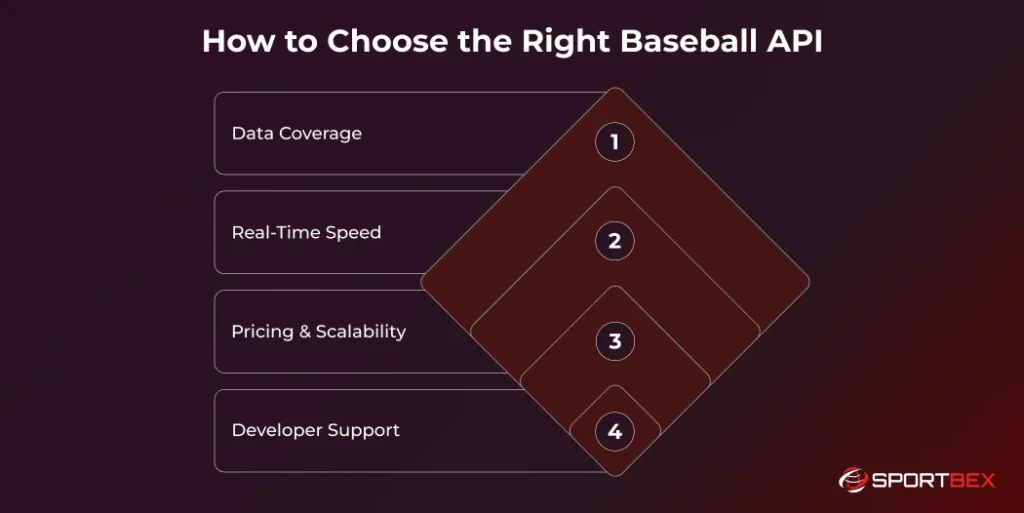
Data Coverage
When choosing a Baseball API, ensure it meets your current and future needs. Some APIs focus solely on MLB, while others cover minor leagues, international games, college baseball, and historical stats. Access to player details, schedules, and advanced stats can significantly improve your scoreboard.
Real-Time Speed
Speed is critical for a great fan experience. The best Baseball APIs deliver updates within seconds of each play, while slower providers may lag by minutes. Choosing an API with fast, consistent updates ensures your scoreboard always reflects the live action accurately.
Pricing & Scalability
Not all APIs cost the same, and pricing structures can vary widely. Look for an API provider that fits your current budget but also offers scalability as your project grows. Flexible plans that let you handle more requests or higher traffic without major changes are ideal.
Developer Support
Good support for developers can make setting up the API much quicker and simpler. When an API comes with clear instructions, examples of how to use it, and a helpful support team, you can solve problems faster and keep your project on track.
Examples of Popular Baseball APIs
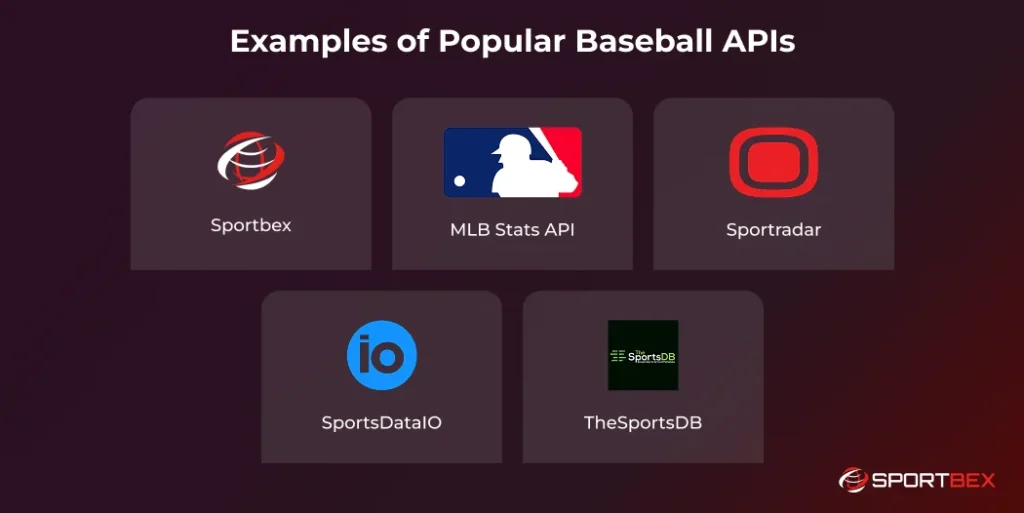
Sportbex
Sportbex provides everything you need for baseball coverage at a great price. Their API gives you real-time scores, player stats, and historical data, making it easy to create baseball scoreboard solutions.
MLB Stats API
The official MLB Stats API gets its data straight from Major League Baseball. It’s very accurate and has all the official stats and game details you could want. Developers can use it to build apps, analyze games, or power fantasy leagues.
Sportradar
Sportradar offers high-quality sports data for businesses. It covers a lot of sports, has powerful tools for analysis, and can handle a lot of traffic for important applications. It’s a top choice for media companies and betting platforms.
SportsDataIO
SportsDataIO makes it easy for developers to use their service. They offer clear instructions, good prices, and reliable support. This makes them a great choice for both single developers and big companies.
TheSportsDB
TheSportsDB has free and premium options with lots of sports coverage, including baseball. Its straightforward API makes it ideal for rapid prototyping and learning. It’s ideal for developers with small budgets or experimental projects.
Get a Ready-Made Platform On Rent.
Get Started Today
Conclusion
A great baseball scoreboard does more than just display scores. It creates an exciting, Real-time baseball scores experience for fans. With the right Baseball API, you can offer MLB live scores and detailed stats that keep fans connected to every moment of the game.
Picking the right API provider is important. Things like data coverage, speed, scalability, and developer support decide how reliable and professional your live baseball match scoreboard will be. With a good API, smart design, and user-friendly features, you can create a platform that’s easy to use and provides real value.
Ready to build your scoreboard? Contact us about our Baseball API. We’ll help you create baseball scoreboard projects that keep fans engaged every inning.
Frequently Asked Questions
A Baseball API provides structured data such as scores, player stats, schedules, and standings. It helps developers build a baseball scoreboard that updates automatically in real time, removing the need for manual entry and ensuring fans always see accurate information.
Yes, most Baseball APIs provide real-time baseball scores that update within seconds of in-game events. This means fans can instantly see score changes, inning updates, or player stats, making your website or app more engaging and interactive.
It depends on the provider. Some APIs only focus on MLB live scores, while others include minor leagues, college baseball, international tournaments, and even historical Baseball Leagues data. Choosing the right provider depends on your project’s needs.
Creating a live baseball match scoreboard with an API is straightforward. You connect to the API, fetch game data (usually in JSON or XML), parse it, and display it on your custom scoreboard UI. Many providers offer documentation and sample code to simplify the process.
Key factors include data coverage (MLB, minor leagues, or international), real-time speed of updates, pricing and scalability as your app grows, and the quality of developer support. These will determine how reliable and user-friendly your scoreboard becomes.
Recent Blog
Best Cricket Betting Sites In India
October 3, 2025
 8 min
8 min
Building a fantasy golf platform using a Golf API
October 2, 2025
 9 min
9 min


